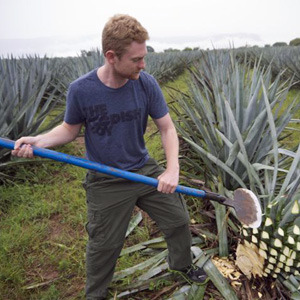The Foodish Boy Travels To The Homeland Of Tequila
Let's be honest. Do any of us Brits actually like Tequila? When "that" person orders a round of shots, complete with salt and lime, no one ever looks too pleased about the situation. Yet, there is something very amusing about drinking some cheap liquor out of a plastic thimble, only to watch just how disgusted everyone is moments later. On my first night in Mexico, I was poured a tequila and told to sip it slowly. To my surprise, the first taste did not provoke the customary averse response. Smooth, crisp, and fragrant, I had wrongly written off a whole spirit, on the basis of a cheap version. So when an opportunity arose to work at the Partida distillery in the town of Tequila, I thought it was about time I discovered the real deal.
Once upon a time in Aztec Mexico, a young woman was walking among the fields when she saw an agave (similar to, but technically not, a cactus) that had been struck by lightning. A small bird had perched on the agave and was drinking the nectar. Moments later the bird started to behave very strangely. To satisfy her curiosity the woman tried the liquid and ran back to the village to share her discovery.
This is one of many stories that speculate how the Aztecs discovered that cooking and fermenting agave juices created a drink that could "aid spiritual communication with the gods." However, this liquid, known as pulque, was only a similar strength to beer. Centuries later when the Spanish invaded in 1518, they brought with them their brandy distilling abilities and soon discovered that, when distilled, pulque made a pretty damn good tipple.
And so tequila was born.
Today, two aspects separate tequila from other spirits. Firstly only the blue agave is used in production, and secondly, with a few exceptions, tequila must be produced and bottled in the state of Jalisco. Other cactus/agave-based spirits exist but are not tequilas (such as mezcal —another favorite Mexican hangover tool). Due to the excellent volcanic soil, two main areas grow blue agave — the highlands of Los Altos and Tequila. I spent my time in latter with Jose Valdez, Maestro Tequilero of Partida Tequila located in the town of Tequila.
My time began in the fields with the agave farmers known as jimadors. The jimadors carefully select the ripe agave (the best sugars are in seven- to 10-year-old plants) and remove the spikes with a coa de jima, a flat-bladed knife on a long pole.
The jimadors are real characters. I harvested along Enrique, who at 61, told me he had been working (and drinking) for 50 years. Harvesting is back-breaking work and I was curious how at 61, Enrique was still chopping away like a young chap. "Alex, when I get drunk I can work for a week nonstop!" I was lucky, during my time on the farm it was cloudy and a reasonable temperature. On a hot day, Enrique tells me they can get through 25 liters of water a day (and I suspect a few tequilas as well)!
Photo Credit: The Foodish Boy
Next up I spent time with Jose, at the distillery learning about tequila production. Although the finer details take years to master, the overall steps are fairly simple. Cut and steam the cacti hearts in huge pressure cookers for 16 to 17 hours for the best flavor. Once cooked, shred the cacti and extract the sugary liquids. This is then left to ferment to about 5 percent before being distilled twice, once to 25 percent, next to 50 percent, and then aged. Yeast is naturally found in the agave and so the only ingredient Partida needs is blue agave.
One morning, I encountered the final steps in production, ageing, when Jose treated me to a unique breakfast — a tequila tasting! He had three of their different types of tequila for me to try. We started with their Blanco, the cleanest example of tequila in its purest form and a far cry from the stuff consumed back home. The tequila was so fresh I could pick out the smells from my time harvesting with Enrique. Next up was their Reposado, aged for at least six months aged in Jack Daniel's American Oak barrels. This retained some of the agave characteristics, but it had a richer taste due to the ageing process. Finally there was the Añejo, also aged in JD barrels. This rich and golden tequila was similar to a whiskey in taste. A tequila to savor and enjoy slowly.
The three were strikingly different and I was amazed by the quality contrast between Partida and the tequila served back in the U.K. Jose has every hope that will change. Firstly, as the tasting shows there are many types of tequila that will appeal to different tastes. Secondly, tequila is incredibly versatile and perfect for cocktail making. Finally, tequila, unlike vodka and gin, is sugar-based and the perfect liquor to get you in the party mood. "Salud Jose! I'll drink to that."
For more information about Partida Tequila, check out the website.

